How Soviet mechanized corps prevented the Germans from taking Kiev on the move
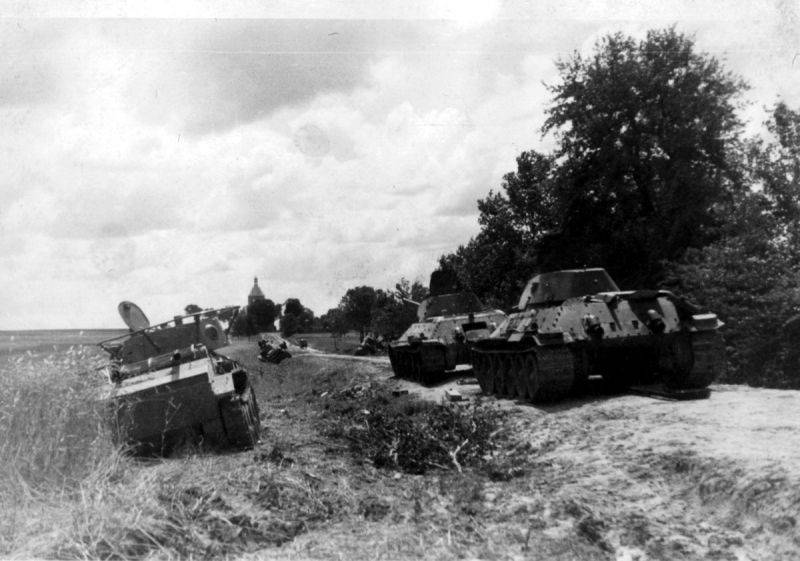
Soviet Tanks T-34 and BT-7, abandoned on the road near the village of Cheremoshnya north of Zolochev. It is most likely that the T-34 tanks were abandoned due to malfunctions. Obviously, the vehicles belong to the 10th Panzer Division of the 15th Mechanized Corps of the 6th Army of the Southwestern Front
On June 29, 1941, the Germans switched from defense to offensive, trying to free the communications of the 48th Motorized Corps and defeat Popel's Russian tank group. The fierce battle lasted for several days, Soviet tanks dug into the ground (there was no more fuel) became a steel fortress for the enemy.
June 28, 1941 The enemy repels a counterattack
Command of the Southwestern Front (Tank battle in the Dubno - Brody area, Part 2) on that day issued order No. 018, according to which mobile formations were to counterattack together with the rifle corps pushed out from the depths. The mechanized corps were finally supposed to get the support of the infantry.
In particular, the 37th Rifle Corps, which had no active missions and simply stood in positions with the front to the west, moved north to the junction of the 15th and 8th mechanized corps. The 36th Rifle Corps received the task of operating against the southern wing of the German group. The 15th mechanized corps was still advancing on Berestechko.
The German command continued to transfer reserves in order to parry the threat that arose on the southern wing of the 1st Panzer Group. Almost all the infantry divisions that followed the tank formations were moved to the south.
As a result, in the Berestechko area there were infantry divisions, whose dense defenses were difficult to overcome, and not weak barriers at the junction of tank and army corps.
The main role in the counterattack on June 28 was played by Anikushkin's 37th Panzer Division, which had not previously taken part in battles and retained its combat potential. More than 200 T-34, BT and T26 tanks remained in its composition. However, there was a shortage of personnel: there were just over 200 thousand people for 4,1 tanks.
Due to the lack of vehicles, 3,5 thousand people remained in the area of the division's base - the city of Kremenets. The division lacked trucks and special vehicles. Because of this, most of the division's artillery pieces, twenty-one 122-mm howitzers remained at the base. This significantly reduced the combat capabilities of the mobile unit. Most of the tanks were light BT-7s and lacked infantry and artillery support. There was also no support from the artillery regiments, which were subordinate to the front.
In the middle of the day on June 28, one of the most massive BT attacks in the initial period of the war took place, the 37th division crossed the Styr River near Stanislavchik. The capture of the crossing itself was carried out by the 37th motorized rifle regiment, its success was developed by the 73rd and 74th tank regiments. The tanks could no longer force the next river, Ostrovka.
German anti-tank defenses knocked out the leading BT in the same place. And our troops did not have artillery to suppress the enemy anti-tank defense. The 37th motorized rifle regiment, which also had weak artillery support, also suffered heavy losses - about 60% of its personnel. The regiment commander, Major Shlykov, and his deputy, Major Schwartz, were killed. In fact, the 37th regiment was defeated.
Fotchenkov's 8th Panzer Division, subordinate to the 15th Corps (part of the 4th Mechanized Corps), fought on the right flank of the counterstrike in the Okhladuva area. Our tankers were unable to penetrate the defenses of the German 297th Infantry Division. The 10th Panzer Division was also unsuccessful. The Germans successfully held back the attacks of our tanks with strong artillery fire.
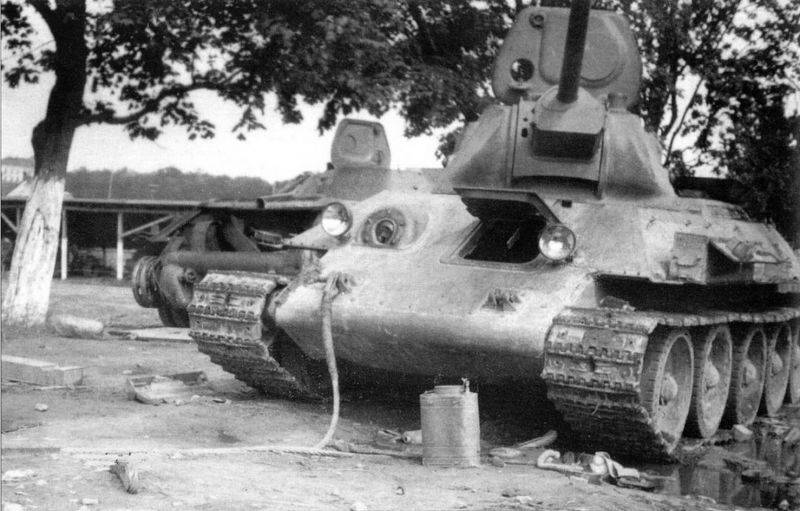
Defective Soviet T-34 tanks abandoned near Zolochev
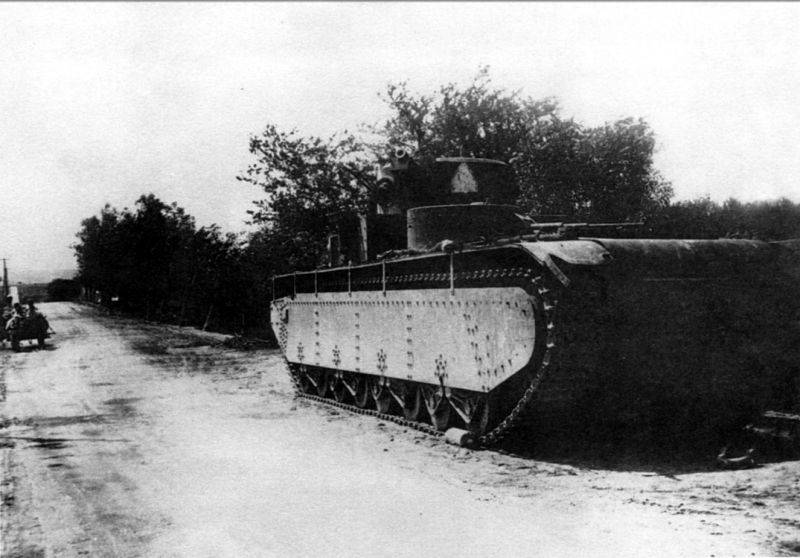
Heavy tank T-35, abandoned due to a malfunction on the Sasov-Zolochev road. This vehicle is from the 67th Tank Regiment of the 34th Panzer Division of the 8th Mechanized Corps. According to the act for the lost T-35 of the 34th Panzer Division, tank No. 200-5: “On 3.07.41/XNUMX/XNUMX, the Avar suffered. cor. per. per. the brake band was burned, rendered unusable, the weapons were removed in the Zolochiv region. "
The threat of encirclement and death of the 8th mechanized corps
Ryabyshev's 8th mechanized corps received the task of advancing on Rovno and ripping open the defense of the southern flank of the German tank wedge to almost the entire depth. The Germans had here the 111th Infantry Division in Dubno, the 16th Panzer and several infantry divisions on the flanks of our 8th Corps.
On the morning of June 28, units of the 12th and 34th Panzer Divisions of the 8th Corps, already seriously drained of blood in previous battles, continued their attack on Dubno. They broke through the enemy's defenses and came close to the city. In the footsteps of the advance group of Popel, other parts of the mobile unit were drawn to the city. However, the forces of the 7th Motorized Division and the remnants of the 12th Panzer Divisions (Ryabyshev's group) had by this time lagged behind the forward detachment of Popel by 20 km. In the afternoon, units of the 75th Infantry and 16th Panzer Divisions wedged into this gap. Ryabyshev's group with heavy fighting continued the offensive and reduced the gap with the forward forces to 10 km. Stubborn battles continued until evening, but our troops were unable to break through the enemy's strong defenses.
By nightfall, the 8th mechanized corps was divided into two parts and partially surrounded. Popel's group was blocked west of Dubno. Ryabyshev's group also found itself under the threat of encirclement.
The breakthrough of the 8th mechanized corps to Dubno and the unsuccessful offensive of the 15th mechanized corps led to a large gap between them. The gap between the 212th motorized division of the 15th corps north of Brody and Ryabyshev's troops northeast of the city was filled with the forces of the German 57th infantry division.
By evening, the Germans had thrown back our 212nd Division and occupied Brody. The 7th motorized division was covered from three sides: from the side of Kremenets and Kozin, the enemy's 16th tank division pressed on it, from the north - the 75th infantry division, and the 57th division intercepted communications at Brod. The positions of Ryabyshev's group were shot through by German artillery, and it was subjected to raids by the Luftwaffe. Ryabyshev began to withdraw his troops to the southeast.
By nightfall, the 7th motorized division and part of the 12th tank division left the cauldron in the area southeast of Brody. There were about 2 thousand soldiers with five tanks and ten guns. True, lagging tanks and subunits dangled along the roads in the Lvov region. Therefore, by July 1, under the command of the 8th mechanized corps, there were already more than 70 KV and T-34, more than 130 BT, T-26 and T-40, about 20 armored vehicles.
Popel's group was completely surrounded. The tankers of the 34th and 12th Panzer Divisions had no hope of outside help. Ryabyshev's group had already been defeated and retreated. The German 16th Panzer Division closed the exit route. The Germans quickly built up a strong anti-tank defense, had strong support. aviation... Therefore, it turned out to be more difficult to break through than to reach Dubno. The attempt of Popel's group to break through back to join the rest of the corps ended in failure.
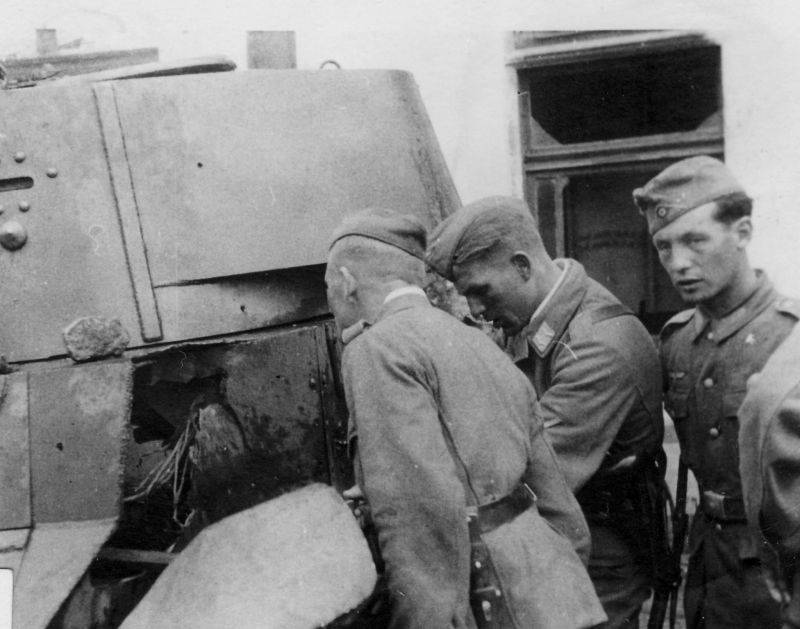
German soldiers inspect the Soviet tank BT-7, knocked out on the street in the town of Ostrog. A vehicle from the 5th Mechanized Corps of the 16th Army. Presumably, a vehicle from the 16th Panzer Regiment of the 109th Motorized Division.
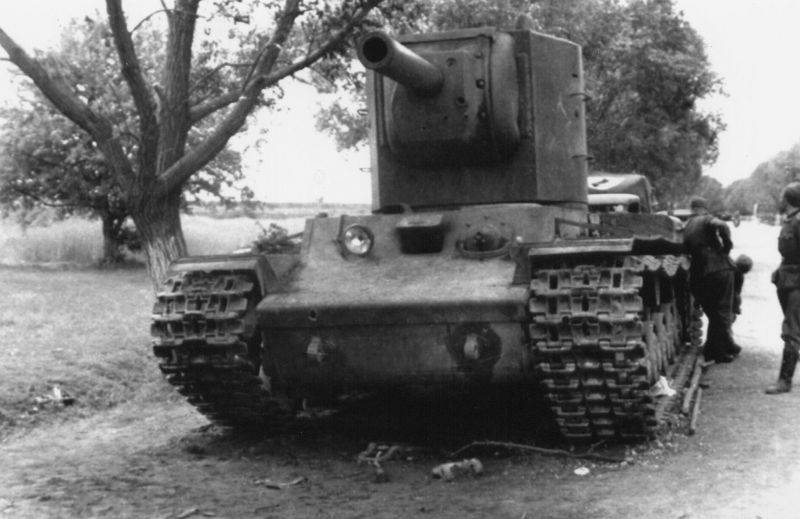
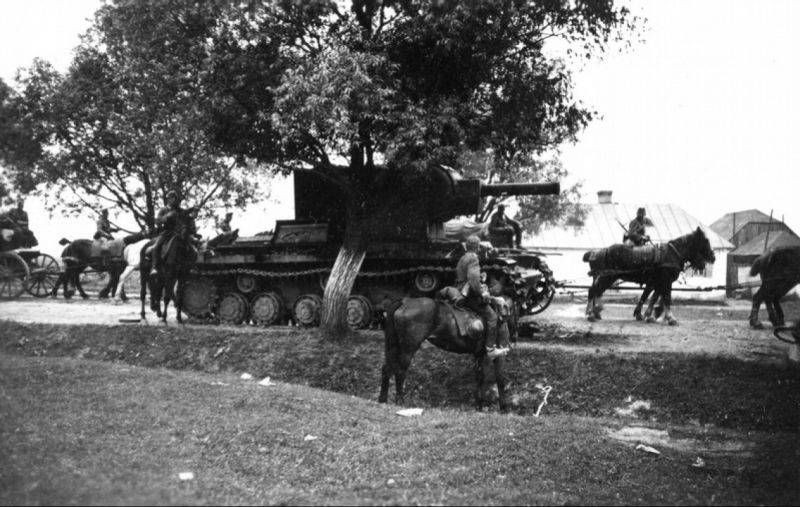
Soviet tank KV-2, abandoned on the road near the city of Rivne during a march as a result of a breakdown or lack of fuel. A vehicle from the 41st Panzer Division of the 22nd Mechanized Corps
Other directions
Meanwhile, the German 11th Panzer Division continued to wage a heavy battle at Ostrog with Lukin's group (parts of the 109th Motorized Division of the 5th Mechanized Corps and the 57th Panzer Division). The 213rd motorized rifle division of the 19th mechanized corps was also included in Lukin's group.
In this sector, the Russians had air supremacy that day: the aviation of the South-Western Front made 400 sorties on a rather small sector of the front. The Nazis had a hard time. German planes have not yet changed airfields and flew from Poland. The Ostrog area was the furthest from the Luftwaffe bases.
In general, the situation in the Dubna direction was in favor of the Germans. The 19th mechanized corps Feklenko left Rovno. On June 29, the 19th corps took up defensive positions on the river. Goryn.
The breakthrough of the Germans to Ostrog caused anxiety in the Soviet Headquarters.
The 19th Army, which was part of the Army Group of the Reserve of the High Command, was instructed to concentrate in the Kiev area. The Kiev fortified area was subordinate to the commander of the 19th Army I.S.Konev.
On the left flank, Muzychenko's 6th Army, which controlled most of the 4th Mechanized Corps, successfully held back the onslaught of the German 17th Army. Russian rearguards, reinforced with tanks, stopped the enemy, and the main forces of the 6th Army successfully retreated to the east.
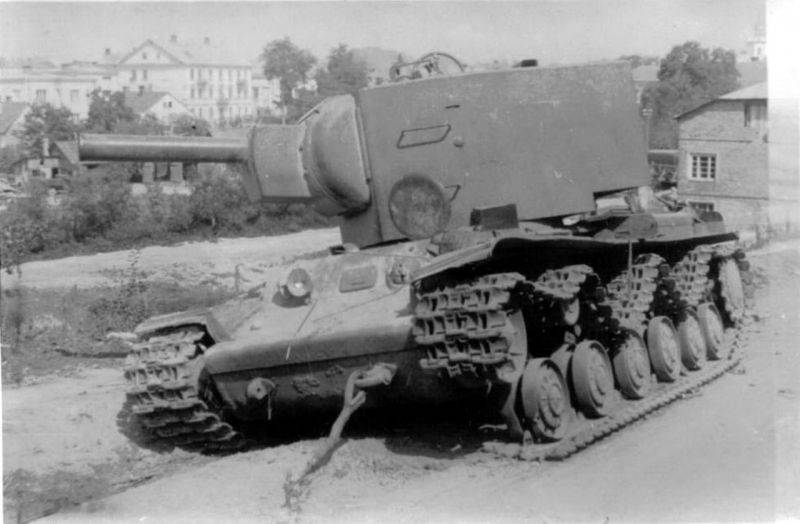
Soviet heavy tank KV-2, abandoned in Zolochev due to a malfunction. The tank was parked on the current Ternopil street - at the beginning of the highway to Ternopil. A vehicle produced in November-December 1940 from the 8th or 12th Panzer Division
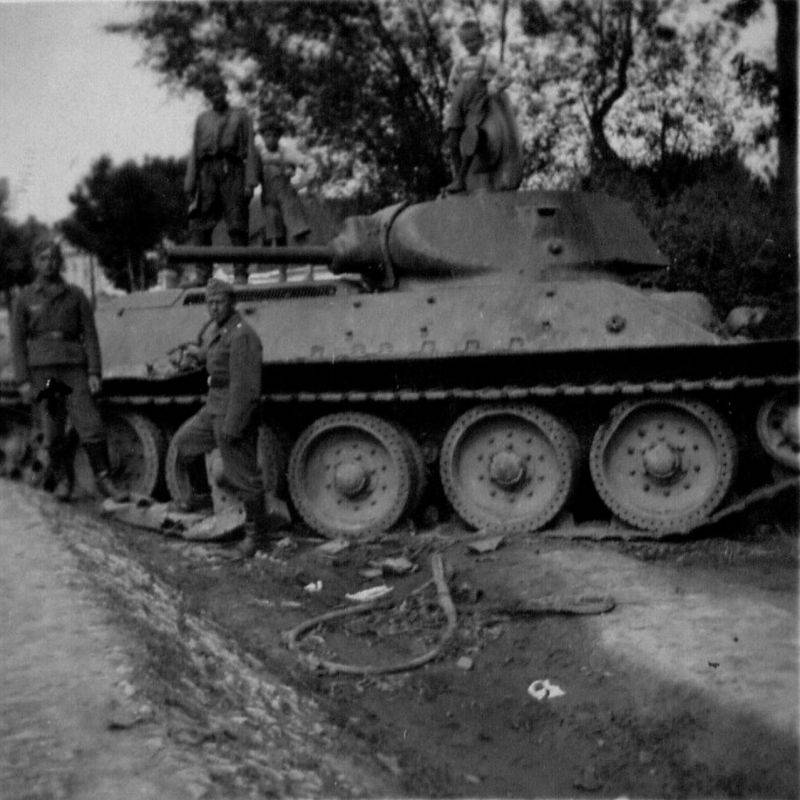
German soldiers next to a Soviet T-34 tank knocked out on Surmichi Street in Dubno
June 29. Going on the defensive and heroic resistance of the Popel group
The command of the South-Western Front, seeing that there were no obvious results of the counterattack, issued Order No. 0025, which was dominated by the phrases “withdraw,” “firmly defend,” “withdraw to the line.” The mechanized corps is supposed to be put into reserve.
Kirponos and Purkaev were sure that the Germans would turn south from Ostrog, and they tried to gather mobile units into a fist in order to fend off a new enemy blow. Therefore, the divisions of the 36th rifle corps, located southeast and south of Dubno (about 10 km from the Popel tankers), were not sent to help the troops of the 8th mechanized corps, which continued to occupy key communications in the rear of the German offensive and went into the rear 11 36st Panzer Division. Although the 34th corps could be used for the release of the 12th and XNUMXth tank divisions and the development of the strike in the Dubno area.
On the 29th, the Germans switched from defense to offensive, trying to free the communications of the 48th Motorized Corps and defeat the Russian tank group.
All day Popel's tankers fought off enemy attacks. The Russians did this very successfully, the Germans suffered losses and rolled back. But on the whole, the situation was almost hopeless.
Popel's group was pressed against the swampy valley of the Ikva River and blocked from the north by the 44th Infantry Division, from the east by the 111th Infantry Division occupying Dubno, from the south by the 16th Panzer Division and from the west by the 57th Infantry Division. From the rest of the 8th mechanized corps, Popel's group was already separated by more than 30 km, occupied by the enemy.
The battle lasted several days, Soviet tanks dug into the ground (there was no more fuel) became a steel fortress for the enemy.
The German command had to transfer troops from the northern flank of the 1st tank group against the 8th mechanized corps. Therefore, there was a pause in the battles in the Lutsk region.
The enemy was unable to advance further in the sector of the 5th Soviet Army. Parts of the 6th Soviet Army were quietly retreating to the east. The retreat of the army was covered by the counterattacks of the combat groups of the 4th mechanized corps (32nd tank division). Active and rather effective counterattacks by our new types of tanks allowed our troops to avoid the cauldron in Lvov.
During the night, units of the 32nd Panzer Division fought back through Lvov, they had to fight not only with the Germans, but also with the Ukrainian Nazis. Thus, our troops in the Lvov direction escaped encirclement.
The Germans had to reinforce the 17th Field Army of the 9th Panzer Division from the 14th Motorized Corps. The 9th division launched an offensive north of Lvov, posing a threat to the rear of the 15th mechanized corps.
However, on the evening of the 29th, the 15th mechanized corps, which had been fighting since June 23, began to withdraw to the front reserve. Its withdrawal from the north was covered by the 212th motorized division, which was stationed south of Brody. And the blow of the German 9th Panzer Division was met by our 8th Panzer Division. Therefore, the 15th mechanized corps avoided the boiler.
At Ostrog, the German 11th Panzer Division continued to repel the attacks of the Soviet troops. Also, the positions of the Germans were ironed by Soviet aviation.
On the northern flank of the German wedge, the command of the South-Western Front began preparing another one by strikes by the forces of Potapov's 5th army - the 9th, 19th and 22nd mechanized corps. The plan was to strike in the general direction of Mlynów, a settlement 15 km north-west of Dubno.
However, the divisions of the 9th and 19th corps had already been drained of blood in previous battles. Therefore, the 22nd mechanized corps was the main striking force. His 41st Panzer Division, which had previously participated in battles only in separate units, as of June 30, consisted of more than 120 tanks (mainly T-26) and 12 guns. The 19th Panzer Division of the 22nd Corps had already been knocked out, leaving 16 tanks in it. The 215th motorized division also suffered heavy losses in previous battles and had only 15 tanks and 12 guns.
The counterstrike was scheduled for July 1. The moment was very favorable, the Germans concentrated their main forces and attention in the Dubno area. The defense of the northern wing was weakened. But the combat capability of the Soviet corps was already low, and they did not have support from the southern flank, so that the blow would achieve serious results.
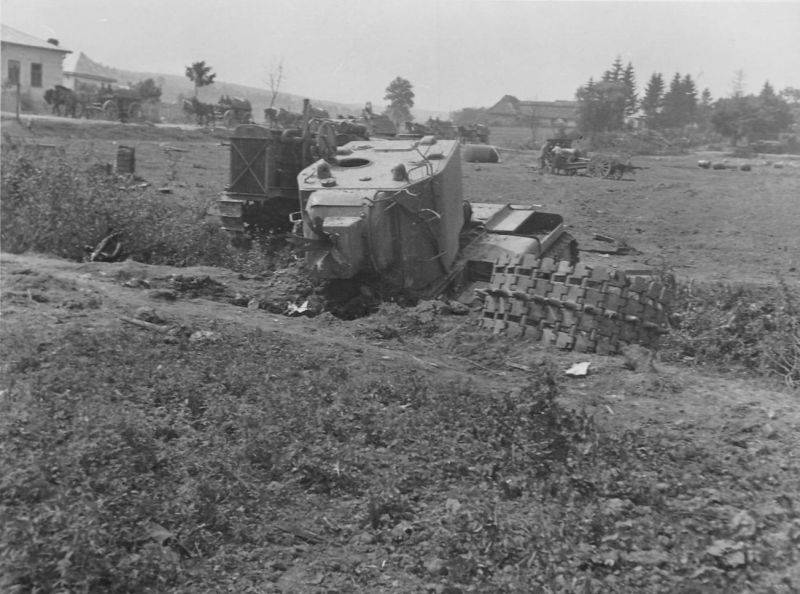
A knocked-out Soviet tank KV-2 with a torn barrel, tractors and artillery abandoned in the floodplain of the Zolotaya Lipa River in the village of Dunaev, Peremyshlyansky District, Lviv Region, about 20 km south of Zolochev. The barrel of the tank was blown up by its own crew. Vehicle from the 12th Panzer Division of the 4th Mechanized Corps
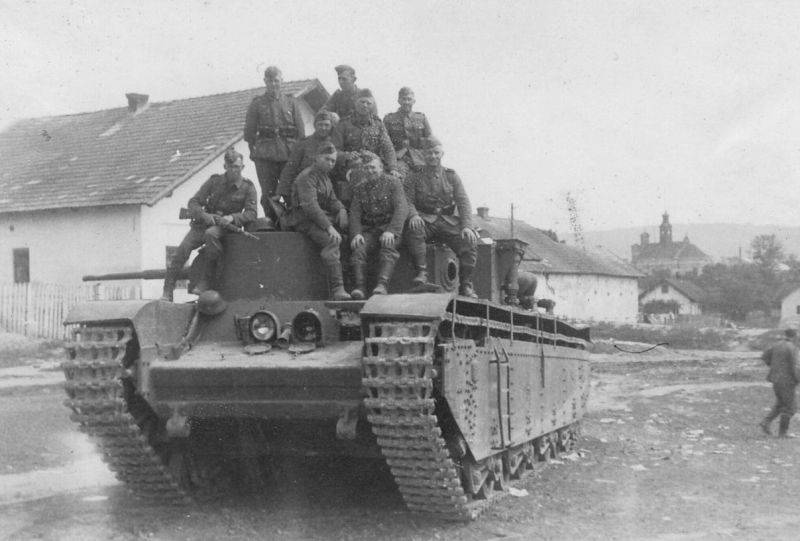
German soldiers are photographed on the armor of a Soviet T-35 tank, abandoned in the village of Bely Kamen, Zolochiv district, Lviv region. According to the act for the lost T-35s of the 34th Panzer Division, tank number 183-3 “Engine accident. The tank was abandoned by the crew in Belo-Kamenka on 30.06. Weapons and ammunition were removed from the vehicle and buried. " A vehicle from the 67th Panzer Regiment of the 34th Panzer Division of the 8th Mechanized Corps
30 June. Retreat
The 6th Army continued to retreat east.
The backbone of the retreating 6th Rifle Corps was the tanks of the 4th Mechanized Corps, and the retreat of the 37th Rifle Corps was covered by the combat vehicles of the 15th Mechanized Corps. The 37th Panzer Division with its counterattacks thwarted all the Nazis' attempts to disrupt the planned withdrawal of our infantry.
As a result, it was not possible to immediately withdraw mobile units to the reserve of the front. They were bound by battle and could not abandon the rifle divisions. True, if it was possible to restrain the enemy with counterattacks, then the situation in the air was different. The Luftwaffe literally smashed and burned the retreating columns of our army.
The acting commander of the 15th mechanized corps, Colonel Ermolaev, wrote in his report:
On the evening of June 30, the Soviet Headquarters permitted the withdrawal of the armies of the South-Western Front to the old border of 1939.
At 23 o'clock, the headquarters of the South-Western Front ordered the troops to withdraw to the line of the fortified areas: Korostensky, Novograd-Volynsky, Shepetovsky, Staro-Konstantinovsky, Proskurovsky and Kamenets-Podolsky, in order, relying on them, to organize a solid defense.

Soviet heavy tank KV-1, abandoned on June 28-29, 1941 on the Ptichye - Verba highway, on the northeastern outskirts of the Verba village, Dubnovsky district, Rivne region. A vehicle from the 1st battalion of the 67th tank regiment of the 34th tank division of the 8th mechanized corps
The last counterattack
On the morning of July 1, 1941, the 20th Panzer Division of the 9th Mechanized Corps of Rokossovsky from the Klevan, Orzhev line struck the enemy and by 15 pm advanced 10-12 km. The Katukov division pressed the enemy's 25th motorized division. However, in connection with the general withdrawal of the armies of the front, this success was not developed.
In the evening, the division was ordered to withdraw. The 35th Panzer Division of the 9th Mechanized Corps also attacked successfully, but at night it received an order to retreat to its original lines.
The most powerful blow to the northern flank of the 1st tank group was inflicted by the 22nd mechanized corps, which at that time had 13 men, about 190 guns, more than 150 tanks (including 15 KV-2 tanks) and more than 20 armored vehicles.
Our troops struck at the junction of the 3rd motorized corps, which reached the Goryn line, and the 298th infantry division near Lutsk. The Germans had weak cover in this sector: the 44th Infantry Division fought in the Dubno area with the Popel group, the 299th Division was also directed to the south. Therefore, Pavlov's 41st Panzer Division quite easily penetrated the weak formations of the enemy and advanced south to 20 km. In the evening, the Soviet tankmen were 15 km north of Dubno.
However, in the evening, an order came for the division and the entire corps to withdraw. The retreat was accompanied by heavy losses: German aviation intensified, bridges in the rear were destroyed.
The 215th Motorized Division, following the 41st Panzer Division in the second echelon, also successfully advanced, providing the left flank and rear of the corps. The 215th Motorized Infantry Division also received an order to retreat and retreated under heavy Luftwaffe attacks. The 19th Panzer Division, advancing in the direction of Mlynów, met with stronger enemy resistance, but also moved forward.
On 2 July, the division had to engage the Leibstandarte Adolf Hitler motorized brigade of the SS. The Germans launched a sudden and powerful blow to the flank and rear of the 19th Panzer Division. Our troops withdrew to their original positions with heavy losses. As a result, the success of the 22 Mechanized Corps' counterattack was of a local nature, the Germans quickly closed the gap with SS units.
The 19th mechanized corps could not launch an offensive that day, since the forces of the previously battered 40th Panzer Division fought defensive battles on the Goryn River. The division, which became de facto a rifle division (lost its tanks), fought off the advanced units of the German 14th Panzer Division. The 43rd Panzer Division of the 19th Corps also fought a successful defensive battle. Nevertheless, the German command gradually strengthened the edge of the wedge.
Muzychenko's 6th Army continued to retreat.
Its troops joined up with the 36th and 37th rifle corps that came from the depths, which changed the bloodied old divisions to the front. At the same time, the Germans launched an offensive with superior forces from the west and north. The 6th Army, without the support of the remnants of the 4th and 15th Mechanized Corps, would have been crushed. Our troops fought successful deterrent battles in the Zolochev area.
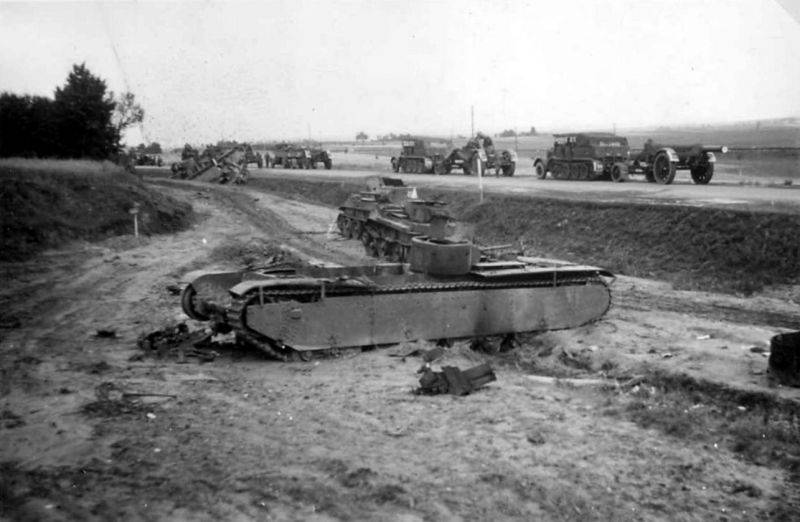
Soviet heavy tank T-35 and light tanks BT-7, knocked out near the Verba-Ptichye highway. In the foreground is a heavy T-35 tank. Behind the T-35 tank there are two damaged BT-7 tanks. Vehicles from the 34th Panzer Division of the 8th Mechanized Corps. A column of heavy half-track Sd.Kfz.8 tractors with German 211-mm mortars of the 1918 model (21 cm Mrs 18) of the OKH reserve is moving along the highway
Results
The counterattacks of our mechanized formations made it possible to avoid the encirclement of our armies in the Lvov direction.
The German command had to halt the breakthrough in the central sector, abandon tank and infantry divisions to fend off counterattacks by Soviet armored forces, and eliminate the threat to the rear and flanks of the 1st Panzer Group in the Dubno area.
As a result, the main forces of the 5th and 6th armies were able to avoid encirclement and destruction, and retreated to a new defensive line.
Soviet troops were defeated in border battles. This is due to a number of reasons.
The Germans fought better, had a lot of experience in agile, fast war. Errors of the Soviet command at the corps-army-front level. The best organization of German mobile units, where tanks were constantly supported by infantry, artillery and aviation. Better communication and organization. The Soviet mechanized corps were "raw": the lack of trained command and tank personnel, the problem of communications, the lack of artillery, air defense and anti-tank equipment. The defeat of the Soviet Air Force, which could not fully support our tankers. Lack of interaction with the infantry (during counterattacks).
Nevertheless, the strikes of the Soviet troops brought down the pace of the enemy offensive in the southern strategic direction, and made it possible to avoid a catastrophe immediately at the initial stage of the war (as on the Western Front). Therefore, the Soviet Headquarters could now transfer troops from the internal districts to the central direction, re-creating the destroyed Western Front. The South-Western Front at the very least, but held out, which made it possible to transfer the 16th and 19th armies to the central sector of the Soviet-German front.
Also, from the very beginning of the war, the Germans realized that in Russia the war would be different: they fought to the death and forced themselves to be respected as an enemy. The Russians suffered heavy losses in men and equipment, but held out as long as they could, and then retreated to new lines and fought again. This was not Poland or France.
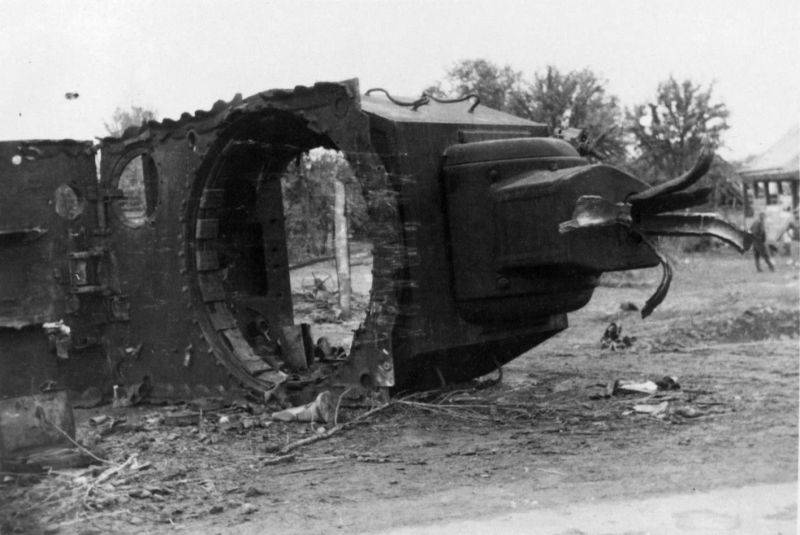
The broken tower of the Soviet heavy tank KV-2, blown up in the village of Podluzhie, Rivne region, on the road between Verba and Dubno. Vehicle from the 12th Panzer Division of the 8th Mechanized Corps
- Alexander Samsonov
- https://ru.wikipedia.org/, http://waralbum.ru/
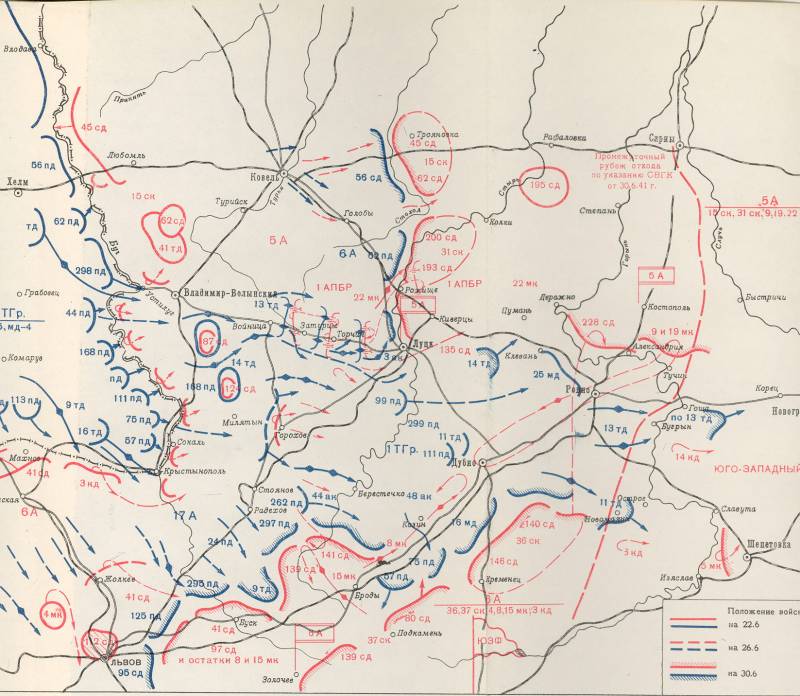
Information